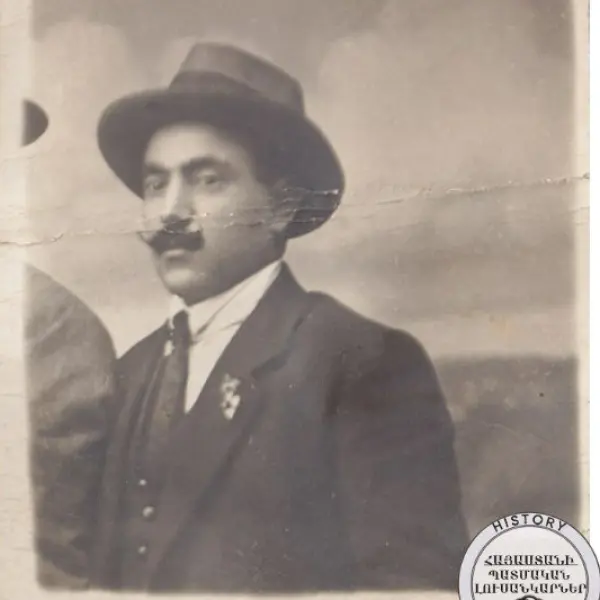Sebastian Murad
Murad of Sebastia, born Murad Khrimian in 1874, was a prominent Armenian fedayee and a key figure in the Armenian national liberation movement during the late Ottoman period. His life was marked by his dedication to defending Armenian communities and resisting oppression, particularly during the Hamidian massacres and the Armenian genocide.
He was born in the village of Govdun, near the city of Sivas, in what is now modern-day Turkey. Coming from a humble rural family, he spent his early years as a shepherd and laborer before moving to Constantinople as a teenager. There, he worked as a porter and became involved in political activism, first joining the Social Democrat Hunchakian Party and later aligning himself with the Armenian Revolutionary Federation. His commitment to the Armenian cause led him to join the ranks of the fedayees, armed resistance fighters who sought to protect Armenian villages from Ottoman repression.
During the 1890s, Murad took part in several uprisings in response to the Hamidian massacres, particularly in the Sasun region. His courage and leadership in battle made him one of the most respected fedayee commanders. In the early 1900s, he continued his resistance efforts, fighting in the Armenian-Tatar clashes and leading the defense of the Zangezur region in southern Armenia. His actions helped safeguard Armenian communities from attacks, earning him a reputation as a fearless and strategic leader.
When World War I broke out, Murad found himself in Sivas at a time when the Ottoman Empire launched the systematic extermination of its Armenian population. Evading arrest, he led a small band of fighters in guerrilla warfare against Turkish forces. By late 1915, he reached the Black Sea coast near Samsun, where he collaborated with Greek resistance groups before escaping to the Russian-controlled port of Batum. From there, he joined the First Armenian Volunteer Battalion of the Russian army and took part in several key battles against the Ottomans, including the Battle of Erzincan in 1916.
As the war progressed, Murad continued his military service, eventually leading Armenian forces in the defense of Baku in 1918. On August 4 of that year, he led a charge against Turkish positions and was killed in battle. His death marked the end of a life dedicated to the defense and survival of his people during one of the most turbulent periods in Armenian history.
Murad of Sebastia remains a symbol of Armenian resistance and resilience. His legacy is honored in historical accounts and among the Armenian diaspora as a testament to the courage of those who fought to protect their communities in the face of persecution and genocide.
He was born in the village of Govdun, near the city of Sivas, in what is now modern-day Turkey. Coming from a humble rural family, he spent his early years as a shepherd and laborer before moving to Constantinople as a teenager. There, he worked as a porter and became involved in political activism, first joining the Social Democrat Hunchakian Party and later aligning himself with the Armenian Revolutionary Federation. His commitment to the Armenian cause led him to join the ranks of the fedayees, armed resistance fighters who sought to protect Armenian villages from Ottoman repression.
During the 1890s, Murad took part in several uprisings in response to the Hamidian massacres, particularly in the Sasun region. His courage and leadership in battle made him one of the most respected fedayee commanders. In the early 1900s, he continued his resistance efforts, fighting in the Armenian-Tatar clashes and leading the defense of the Zangezur region in southern Armenia. His actions helped safeguard Armenian communities from attacks, earning him a reputation as a fearless and strategic leader.
When World War I broke out, Murad found himself in Sivas at a time when the Ottoman Empire launched the systematic extermination of its Armenian population. Evading arrest, he led a small band of fighters in guerrilla warfare against Turkish forces. By late 1915, he reached the Black Sea coast near Samsun, where he collaborated with Greek resistance groups before escaping to the Russian-controlled port of Batum. From there, he joined the First Armenian Volunteer Battalion of the Russian army and took part in several key battles against the Ottomans, including the Battle of Erzincan in 1916.
As the war progressed, Murad continued his military service, eventually leading Armenian forces in the defense of Baku in 1918. On August 4 of that year, he led a charge against Turkish positions and was killed in battle. His death marked the end of a life dedicated to the defense and survival of his people during one of the most turbulent periods in Armenian history.
Murad of Sebastia remains a symbol of Armenian resistance and resilience. His legacy is honored in historical accounts and among the Armenian diaspora as a testament to the courage of those who fought to protect their communities in the face of persecution and genocide.
Contributed by OldPik on January 6, 2025
Image

You must be logged in to comment on the photos.
Log in
Log in
Nearby photos
Photograph of Armenian politicians Levon Shant, Hovhannes Devejyan, Hovhannes Kajaznuni, and Simon Vratsyan (taken in Egypt)














No comment yet, be the first to comment...